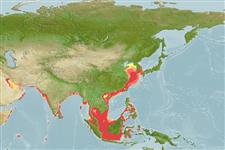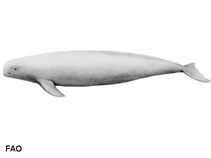Neophocaena phocaenoides (Cuvier, 1829)
Finless porpoise| Native range | All suitable habitat | Point map | Year 2050 |

|
| This map was computer-generated and has not yet been reviewed. |
| Neophocaena phocaenoides AquaMaps Data sources: GBIF OBIS |
Classification / Names Common names | Synonyms | CoL | ITIS | WoRMS
Mammalia | Cetartiodactyla | Phocoenidae
Environment: milieu / climate zone / depth range / distribution range Ecology
Pelagic; anadromous (Ref. 75906); depth range 0 - 250 m (Ref. 356). Tropical; 90°N - 7°S, 46°E - 130°E
Distribution Countries | FAO areas | Ecosystems | Occurrences | Introductions
Indo-West Pacific and Asia Inland Waters: Neophocaena phocaenoides phocaenoides: Persian Gulf, South China Sea, East China Sea, Indonesia, Philippines, Turtle Islands, Sulu Sea; Neophocaena phocaenoides sunameri: China, Korea, Japan, East China Sea; Neophocaena phocaenoides asiaeorientalis: Yangtze River, China (Ref. 1522). Found in tropical to warm temperate coastal waters (Ref. 81021).
Length at first maturity / Size / Weight / Age
Maturity: Lm 140.0, range 135 - 145 cm Max length : 227 cm TL male/unsexed; (Ref. 81030)
Found in both fresh and marine. Feeds on small fishes, squids and shrimps; also ingests some plant material including leaves and rice (Ref. 1394). In 2006, a population survey was able to record a total of 300 individuals of Neophocaena phocaenoides asiaeorientalis, as experts provide an estimate of 1,400 individuals based on the said survey. This is considered a 50% decline from the survey done in 1991 (Ref. 85336). Found in tropical to warm temperate coastal waters, i.e., shallow bays, mangrove swamps, estuaries and large rivers, but mainly prefers estuarine waters (Ref. 81021). Occurs singly, in pairs, or in small groups of up to 12 individuals. Not as showy as other dolphins; though, they are occasionally seen breaking the surface in calm seas (Ref. 801). Feeds on small fishes, squids and shrimps; also ingests some plant materials including leaves and rice (Ref. 1394).
Life cycle and mating behavior Maturity | Reproduction | Spawning | Eggs | Fecundity | Larvae
Main reference
References | Coordinator | Collaborators
Tan, J.M.L. 1995. (Ref. 936)
IUCN Red List Status (Ref. 130435)
Vulnerable (VU) (A2cde+3cde+4cde); Date assessed: 10 August 2017
CITES status (Ref. 108899)
Appendix I: International trade banned
CMS (Ref. 116361)
Appendix II: Migratory species conserved through agreements
Threat to humans
Human uses
Fisheries: commercial
FAO - Fisheries: landings, species profile | FishSource | Sea Around Us
Tools
More information
Internet sources
BHL | BOLD Systems | CISTI | DiscoverLife | FAO(Fisheries: species profile; publication : search) | Fishipedia | GenBank (genome, nucleotide) | GloBI | Gomexsi | Google Books | Google Scholar | Google | PubMed | Tree of Life | Wikipedia (Go, Search) | Zoological Record
Estimates based on models
Preferred temperature
(Ref. 115969): 24.4 - 29.2, mean 28.3 (based on 1892 cells).
Resilience
(Ref. 69278):
High, minimum population doubling time less than 15 months (K=0.71-0.74; tm=5).
Price category
(Ref. 80766):
Unknown.



